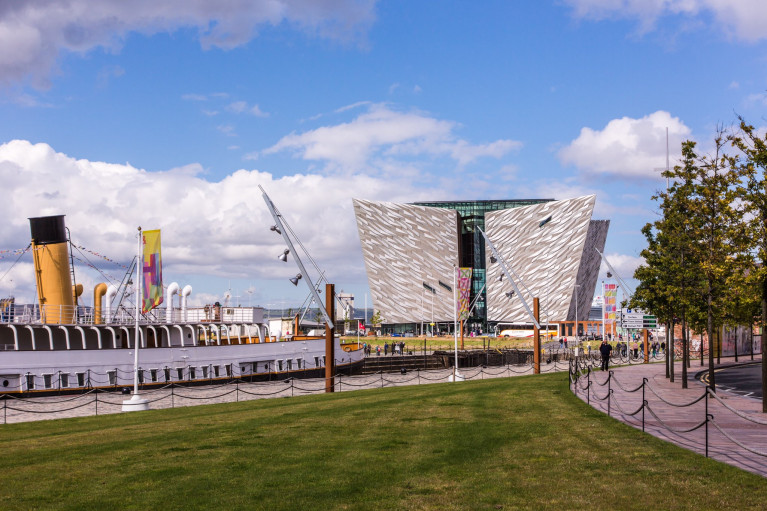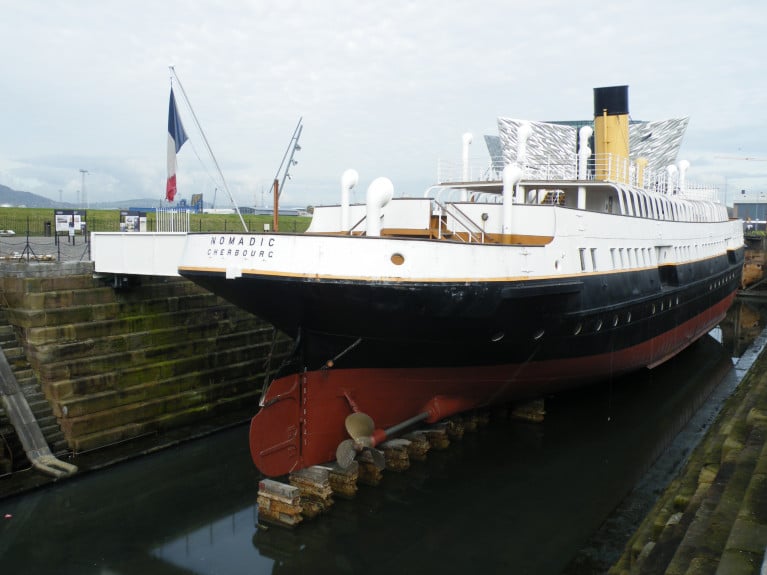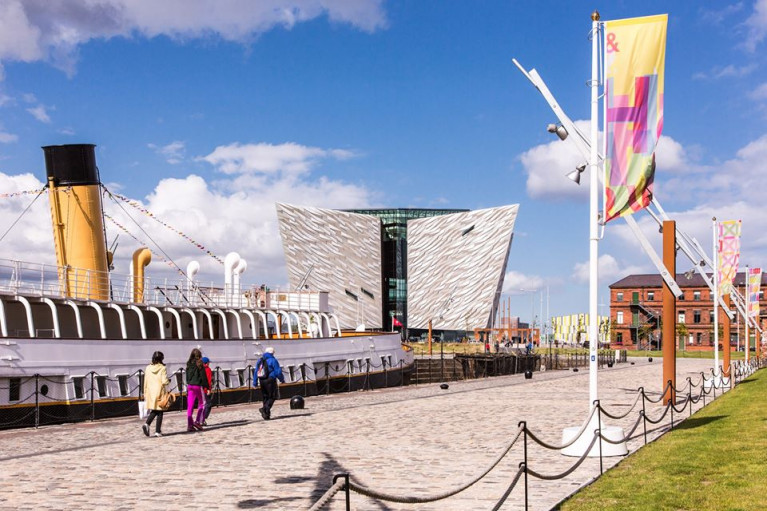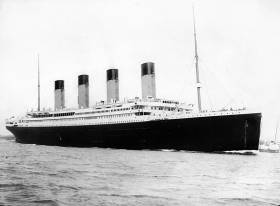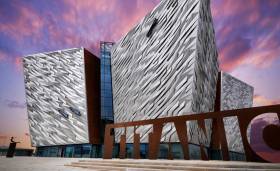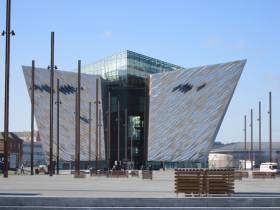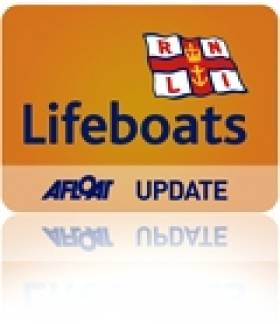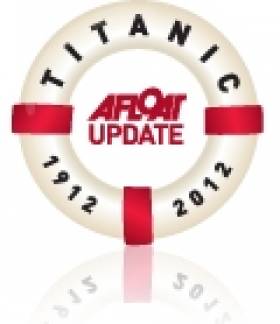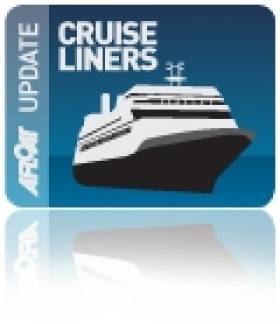Displaying items by tag: Titanic Belfast
Maritime Belfast Celebrates 10th Year of Titanic Beflast With New Gallery Refreshment Programme
Titanic Belfast which celebrates its 10th birthday, has according to a report generated an estimated £430 million in direct spend for the Northern Ireland economy since opening its doors a decade ago.
The world-leading visitor attraction Titanic Belfast, has welcomed almost 6.5 million visitors from over 145 countries and has embarked on its most ambitious project, and largest single investment to date, a multi-million pound gallery refreshment programme.
The investment will come from the Titanic Belfast Gallery Refreshment Fund, established when the building opened as part of the commercial operator agreement and held by the charity owner, Maritime Belfast Trust.
Following an international tender competition, Titanic Belfast has appointed OPERA Amsterdam and Studio Louter to design and deliver the significant project.
Judith Owens MBE, Chief Executive of Titanic Belfast said: “As part of the 10th birthday celebrations, we are delighted to announce a multi-million pound gallery refreshment programme which will deliver a world-class spectacle by combining innovative technology with the authentic Titanic story to deliver an enriched, emotive and immersive visitor experience which will sustain Titanic Belfast as a must-see global attraction for years to come.
“Since opening on Saturday 31st March 2012, Titanic Belfast has gone from strength to strength and played a key role in the resurgence of tourism, not only for Belfast and Northern Ireland, but for the island of Ireland as a whole. In the last 10 years, we have firmly established ourselves on the local, national and international stage, winning a host of prestigious accolades including being named as the World’s Leading Tourist Attraction.
“82% of visitors come from outside of Northern Ireland demonstrating the important driver this iconic building plays for inbound tourism. Titanic Belfast has not only driven leisure tourism but has been fundamental in reinvigorating Belfast’s event industry as one of the city’s signature venues having hosted over 3,000 business and leisure events. We are firmly committed to preserving the authenticity of Belfast’s maritime and industrial heritage and in playing a pivotal role in the regrowth of local tourism post-pandemic, particularly as international travel resumes.”
Kerrie Sweeney, Chief Executive Officer of Maritime Belfast Trust, charity owner of Titanic Belfast, said: “On behalf of Maritime Belfast Trust we would like to congratulate Titanic Belfast on reaching this 10 year milestone as well generating the local economic impact of £430m. Located at the heart of Belfast’s Maritime Mile it plays a key part in making our iconic waterfront a vibrant, accessible heritage destination.
Alongside Titanic Belfast, we are delighted to announce plans for the Gallery Refreshment programme in 2023, our most ambitious project and largest single investment to date. Delivered through the Titanic Belfast Gallery Refreshment Fund, it will ensure Titanic Belfast maintains standout, remains a catalyst and key enabler for the regrowth of the tourism industry, driving visitors to Belfast, Northern Ireland and from international markets.
We look forward to working with Titanic Belfast, Opera Amsterdam and Studio Louter on the delivery of the project which will enable Titanic Belfast to continue to push boundaries and maintain international standout, whilst preserving our rich maritime heritage for current and future generations to enjoy.”
Titanic Belfast has an exciting programme of events planned to mark their 10th birthday.
Maritime Heritage in NI Where SS Nomadic & Titanic Belfast Receive Covid Recovery Grants
The tender that served RMS Titanic at Cherbourg, France, which forms part of the liner's visitor attraction centre in Belfast Harbour, have both received £1.63m from a total £5m plus funding from the UK's Heritage Recovery Fund, writes Jehan Ashmore.
According to the National Historic Ships UK, the funding awarded to the tender SS Nomadic and Titanic Belfast, is to support the recovery and reopening of the centre, as well as protect the future of its heritage – a significant driver of global tourism and economic growth for Northern Ireland.
SS Nomadic, capable of 1,000 passengers, divided into three classes, was purpose built for the White Star Line and is the last remaining ship from the company, which highlights the historic story of Belfast’s maritime heritage and as the biggest Titanic artefact.
Designed and built by Harland and Wolff in 1910-11, the SS Nomadic has many of the same luxurious finishes as RMS's Titanic / Olympic, and is a quarter of the size. The tender was also designed to transport luggage and stores to and from the liners anchored offshore.
In addition the funding, totalling more than £5m was awarded to other heritage organisations including the National Trust NI and Creggan Country Park along with self-employed tour guides, stonemasons, coppersmiths and conservators.
The awards aim to safeguard jobs for the long-term and enable recipients to adapt and prepare for reopening or restarting work when restrictions permit.
“The risks to historic sites, attractions and essential heritage jobs and skills from a sudden and dramatic loss of income as a result of the pandemic, have put the heritage and visitor economy in crisis, and we hope this funding will play a vital role in their recovery,” states Paul Mullan, director, Northern Ireland, National Lottery Heritage Fund.
He added “Heritage has an essential role to play in making communities better places to live, creating economic prosperity and supporting personal wellbeing. All of these are going to be vitally important as we emerge from the current pandemic.”
SS Nomadic: Maritime 'Dry Docked' Heritage
Following the White Star career, SS Nomadic, saw active service in both World Wars as a troop carrier. Nomadic also tendered thousands of passengers to the world’s great liners also in Cherbourg, to serve the 'Cunarders' Queen Mary and Queen Elizabeth. This was followed with the tender becoming a Paris based restaurant and party venue on the bank of the River Seine.
Fortunes changed and the Nomadic relocated downriver, having languished for decades in Le Havre, when enthusiasts became aware of its plight, and began a campaign to ‘Save the Nomadic’ from scrappage. This ultimately led to the tender's towed return to Belfast and with shipyard origins where the veteran vessel underwent a major restoration project.
Find out more about the 'Shipshape' Network Northern Ireland zone 'here'.
Dublin's Grand Canal Dock (Basin) Graving Dry-Docks
As for Ireland's maritime heritage, Afloat previously reported last week, where in the case of Dublin, Waterways Ireland plan to sell off the historic graving dry-docks in the Grand Canal Basin. As also reported in 2016, the saved 'Georgian' dry-docks, along with a rare surviving historic Irish built ship, aptly constructed in the capital, Naomh Éanna remains in the larger dry-dock which links the Inland Waterways.
The former Aran Islands passenger, cargo and livestock ferry, was then also saved from scrapping following a petition. This led to plans for a new static role as previously reported. The last ship to serve the Aran Islands directly from Galway was Oileáin Árann (see in Icelandic waters).
In recent years, Dublin's other dry-docks, one dating to the 1950's (last year, underwent infilling) and a much older 1850's dry-dock was infilled in the Celtic Tiger era, but since further plans to excavate! As for the current scene, Afloat is awaiting an update from the port.
Boost in Profits at Titanic Belfast as Over 900,000 Visit Centre
So it's full steam ahead at one of Ireland's most popular visitor attractions as profits at Titanic Belfast increased last year by 63% to £4.2m.
According to the Belfast Telegraph, in the 12 months to the end of last March, more than 900,000 people visited the world's largest Titanic visitor experience in Belfast. This contributed to revenues increasing by 10% from £16.3m to £17.9m.
The 9% increase in visitors helped Titanic Belfast Ltd's pre-tax profits increase from £2.5m to £4.2m.
The visitor attraction celebrates Belfast as the birthplace of the ill-fated Harland & Wolff built liner that sank on its maiden voyage in 1912.
More on the story here.
Titanic Wreck Still Marvels 32 Years On From Its Discovery
#Titanic - This past Friday 1 September marked 32 years since the discovery of the wreck of the ill-fated Titanic.
Irish deep-sea diving expert Rory Golden was among the first to set eyes on its remains in person during an expedition in 2000 — an “awe-inspiring” moment, as he tells the Irish Examiner’s Conor Kane.
Visitors to Titanic Belfast can get a taste of what it felt like to witness the shipwreck first hand, in the Titanic Beneath portion of the Titanic Experience tour which displays documentary footage from a deep-sea expedition beneath a glass floor.
But for Golden, nothing compares to being there in the moment — or getting to touch with his own hands the ship’s wheel he helped recover from the wreck site.
The Irish Examiner has much more in the story HERE.
Top Travel Industry Award For Titanic Belfast
#TitanicBelfast - Titanic Belfast is Europe's leading tourist attraction, after scooping a top gong at a major industry awards ceremony.
Paying tribute to the ill-fated ocean liner RMS Titanic and its history in the city, the Belfast Lough visitor centre took the award for Europe's Leading Visitor Attraction at the World Travel Awards in Sardinia last night (Monday 5 September), according to TheJournal.ie.
The Guinness Storehouse, Buckingham Palace and the Colosseum in Rome were among the renowned tourist hotspots beaten to the prize, the first for Northern Ireland in the history of the awards.
As previously reported on Afloat.ie, the four-year-old venue saw a 2% growth in visitor numbers in the 12 months before March this year, along with a 7% growth in revenues.
Profits Fall As Revenue Rises At Titanic Belfast
#TitanicBelfast - Pre-tax profits at Titanic Belfast have dropped by more than 32% in the last 12 months despite a rise in the centre's revenue, as The Irish Times reports.
A 7% growth in revenues at the popular Belfast Lough tourist attraction, which charts the history of the RMS Titanic, has been offset by increases in administrative expenses and staffing costs in the latest accounts.
But directors cite a 2% growth in visitor numbers since March last year, three-quarters of them from outside Northern Ireland, as well as the centre's estimated contribution of some £105 million to the local economy since opening four years ago.
The Irish Times has more on the story HERE.
RNLI Honours Volunteers, Celebrates 190 Years In Belfast
#RNLI - The RNLI brought two of its all-weather lifeboats into Belfast on Wednesday 17 June for the charity’s 190th anniversary of saving lives at sea.
To mark the milestone, the RNLI hosted an awareness day in the Titanic Quarter with a full display of their life saving equipment including the Severn and Trent class all-weather lifeboats, RNLI beach lifeguards and their vehicles and the Flood Rescue kit.
The lifeboats were crewed by volunteer lifeboat crew members from Northern Ireland lifeboat stations.
First Minister Peter Robinson visited the event to meet with the RNLI lifeguards and volunteer lifeboat crew, view the lifesaving equipment and learn about the work of the charity in Northern Ireland.
The First Minister also boarded the Severn class lifeboat for a short trip around Belfast Harbour.
"We wanted to bring a little bit of the RNLI to Belfast city," said RNLI divisional operations manager Gareth Morrison. "There is huge awareness of the work of the charity out on coast and at the inland stations where we are present but we wanted to bring our volunteers and equipment into the city for people to see.
"With the awards taking place in the Titanic centre it was a fitting way to mark 190 years saving lives."
The day culminated with the RNLI Annual Presentation of Awards for Northern Ireland fundraising and operational volunteers, which this year was held at Titanic Belfast.
RNLI volunteers and supporters from across Northern Ireland were recognised for their dedication and commitment to raising funds and awareness for the lifesaving charity and for playing a pivotal role in ensuring lifeboat crews and lifeguards can continue to save lives at sea.
Guest of honour and presenting the awards was RNLI chairman Charles Hunter-Pease, who was attending his first awards ceremony in Northern Ireland since taking up his role with the charity last year.
The awards included five gold badges, three silver badges, six bronze badges, 14 inscribed statuettes, six regional supporter awards and six certificates of thanks.
Among the gold badge recipients was Rita Jarvis from the Bangor branch, who was described as an outstanding volunteer who had worked tirelessly for over 20 years for Bangor RNLI.
Hubert Annett from Kilkeel was acknowledged as one of the station's characters, who had performed various roles including that of deputy launching authority over the last 20 years.
Guests heard how Kay Magee joined Maghera RNLI over 30 years ago and remained a driving force at the inland branch throughout.
Gavin Weatherall from Newtownabbey RNLI was acknowledged for his devotion to fundraising for over 25 years with roles including that of treasurer and more recently secretary of the branch.
Patricia Ritchie, the fifth of the gold badge awardees, was described as a highly devoted secretary at Portadown where she has worked tirelessly for more than 23 years.
Two gold badge recipients collected their awards at the RNLI’s annual presentation of awards in London last month. These included Lennie Lawson, deputy launching uthority at Portaferry RNLI and Patricia Crossley, chairman of the Ballymoney fundraising branch. Merwyn Hanna MBE from Kilkeel Fundraising Branch was made an Honorory Life Governor.
Praising the awardees, Hunter-Pease said: "It all starts with the people who give their time, their donation and their expertise.
"Over the decades, as we have expanded our service and developed new craft and facilities; our volunteers, fundraisers and supporters have become more important than ever.
"Without them there is no lifeboat station, no lifeguard unit, no flood rescue team, and no coastal safety work preventing tragedies."
Titanic Belfast Is 'Euro Tourism Success Story'
#Titanic - Titanic Belfast is second only to the Guinness Storehouse in terms of visitor numbers in its first year, as The Irish Times reports.
NI Deputy First Minister Martin McGuinness, who joined First Minister Peter Robinson at an event to mark the first anniversary of the Belfast Lough-side visitor centre's opening, said the total of 807,340 visitors exceeded expectations and is “an outstanding European tourism success story”.
Operators of the Titanic Visitor Experience at Titanic Belfast said people from 128 different countries had come to see the exhibits, including Britain's Queen Elizabeth II and noted Titanic enthusiast James Cameron.
The Irish Times has more on the story HERE.
Titanic Plan Set to Go On Display
#TITANIC - The Irish Times reports that a hand-drawn plan of the Titanic will go on display at the visitor's centre dedicated to the tragic vessel in Belfast.
The enormous 10-metre drawing was used during an inquiry into the Titanic's sinking in 1912, and was donated anonymously to Titanic Belfast after selling at auction this summer for more than £200,000 (€250,000).
“I would say that it transcends economic value, given its role in Titanic history," said paper conservator Sean Madden, who worked on the project in his Lurgan studio. "Restoring and preparing the plan for display at Titanic Belfast has been an honour.”
The plan was shown at Belfast City Hall in April during the Titanic centenary events, and is set to be installed in the Aftermath Gallery at Titanic Belfast on the shores of Belfast Lough shortly.
The Irish Times has more on the story HERE.
Three’s A Crowd as Liners Line-Up in Dublin
#TREESOME CRUISECALLS – This morning three cruiseships arrived into Dublin Bay and all within less than an hour. Currently the trio are berthed closely together in the centre of Dublin port, which this year expects to see around 90 such vessels visiting this season, writes Jehan Ashmore.
First to arrive was Holland America Line's Prinsendam (1988/37,983grt) from Liverpool, followed by Swan Hellenic's Minerva (1996/12,449grt) from Portsmouth and lastly Peter Deilmann's Deutschland (1998/22,496grt) from Douglas.
In 2011 around 200 large cruise vessels visited Irish shores carrying more than 308,000 passengers and crew. The cruise sector in fact has doubled in terms of visitors, in just over 7 years when 142 cruise ships called in 2004 bringing more than 146,000 passengers and crew.
Large ports such as Dublin, Cork and Belfast handled over 85% of the total cruiseship visitor numbers in 2011. Of these ports only Dublin saw an increase, leaving the others remaining relatively unchanged. However, as previously reported on Afloat.ie, the opening earlier this year of Titanic Belfast is attracting more cruise calls to Belfast.



























